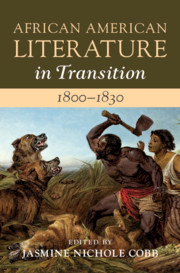Book contents
- African American Literature in Transition, 1800–1830
- African American Literature in Transition
- African American Literature in Transition, 1800–1830
- Copyright page
- Contents
- Figures
- Contributors
- Preface
- Chronology
- Introduction
- Part I Black Organizational Life before 1830
- Part II Movement and Mobility in African American Literature
- Part III Print Culture in Circulation
- Part IV Illustration and the Narrative Form
- Chapter 10 Theorizing Vision and Selfhood in Early Black Writing and Art
- Chapter 11 Embodying Activism, Bearing Witness
- Chapter 12 Visual Insubordination within Early African American Portraiture and Illustrated Books
- Index
Chapter 12 - Visual Insubordination within Early African American Portraiture and Illustrated Books
from Part IV - Illustration and the Narrative Form
Published online by Cambridge University Press: 11 March 2021
- African American Literature in Transition, 1800–1830
- African American Literature in Transition
- African American Literature in Transition, 1800–1830
- Copyright page
- Contents
- Figures
- Contributors
- Preface
- Chronology
- Introduction
- Part I Black Organizational Life before 1830
- Part II Movement and Mobility in African American Literature
- Part III Print Culture in Circulation
- Part IV Illustration and the Narrative Form
- Chapter 10 Theorizing Vision and Selfhood in Early Black Writing and Art
- Chapter 11 Embodying Activism, Bearing Witness
- Chapter 12 Visual Insubordination within Early African American Portraiture and Illustrated Books
- Index
Summary
This chapter scrutinizes early frontispieces contained within books by Phillis Wheatley and Olaudah Equiano and then proceeds to examine the illustrated antislavery books of Moses Roper and Henry Bibb (both of which also contain frontispieces as well as other types of illustrations). Although Roper’s book was published in 1837 and Bibb’s in 1849, this chapter argues that both men (being born in 1815 and having participated in the antislavery movement) were responding to the abject treatment of the enslaved in earlier antislavery materials. The words of the text interact with its visual optic to interpellate the reader and envision a figurative mode of agency and self-possession for the enslaved body and the freed Black subject. The chapter concludes with a forward glance at artworks by Kara Walker and Glen Ligon that also attempt to excavate (although in a more abstract way) the trace of a resistant visual tradition within African American literature and US visual culture.
Keywords
- Type
- Chapter
- Information
- African American Literature in Transition, 1800–1830 , pp. 316 - 343Publisher: Cambridge University PressPrint publication year: 2021

